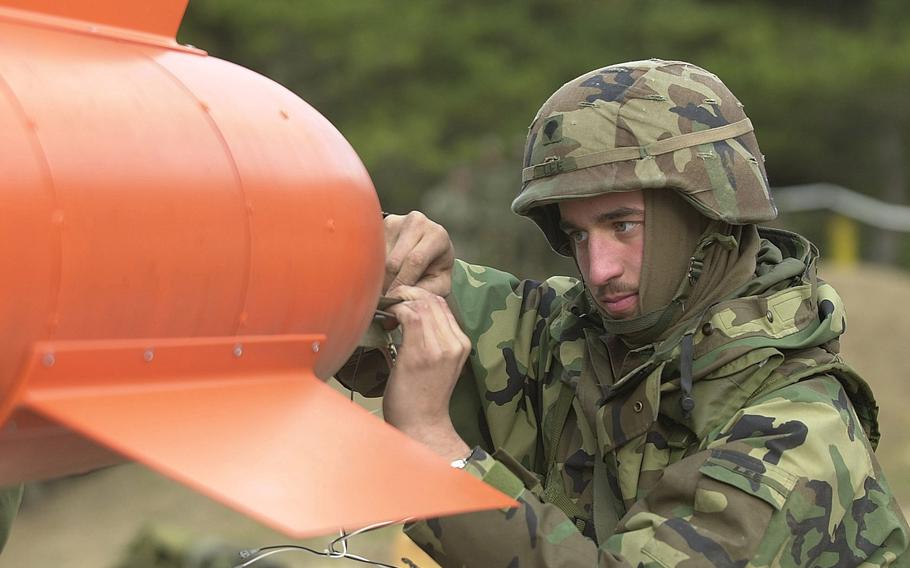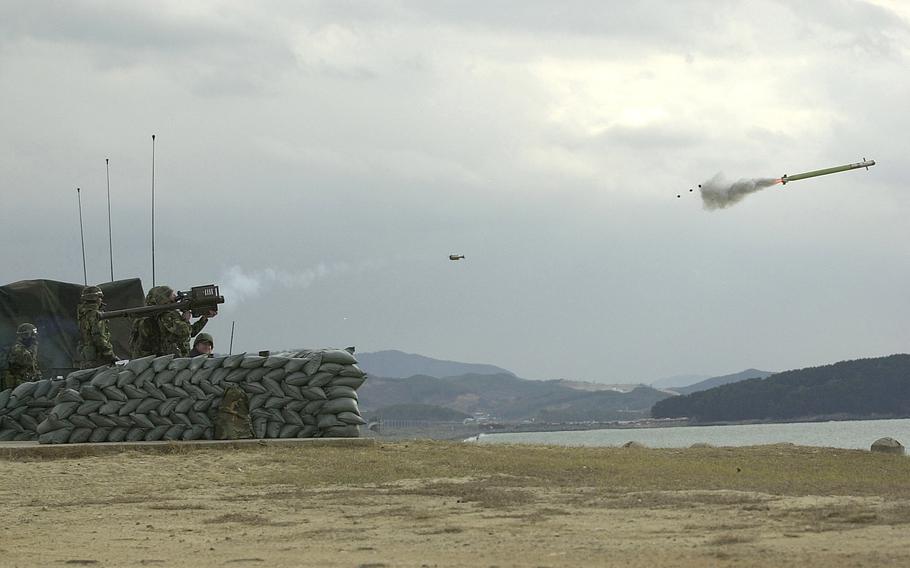
Army Spc. Dustin Lee, ordnance specialist, Battery 5 Battalion 5th Air Defense Artillery, Camp Casey, wires the engines of the Ballistic Aerial Target (BAT) for an electronic start at Chulmae Range, Korea, during Operation Sea Strike, Nov. 27, 2001. (Andy Dunaway/Stars and Stripes)
This article first appeared in the Stars and Stripes Pacific edition, Dec. 1, 2001. It is republished unedited in its original form.
CHULMAE RANGE, South Korea — When Afghan fighters resisted the Soviet Union’s invasion, one of the well-sung heroes was the 35-pound Stinger, an easily transportable anti-aircraft missile.
The slender heat-seeking missile is credited with downing 270 Soviet aircraft, hampering air assaults and hastening the Soviets’ withdrawal. The Stinger, which debuted in 1982, remains a core of the Army’s low-altitude air defense.
Soldiers from 5th Battalion, 5th Air Defense Artillery, fired Stingers on Tuesday at beachside training range on the West Sea, about 30 miles north of Kunsan Air Base. Most were from Delta Battery, the largest Stinger Avenger unit in the Army.
“The main thing we want to do is to give them confidence to fire the missile,” said 2nd Lt. Shelton Matsey.
The unit uses a modified Humvee called an Avenger that has a swiveling unit with eight Stinger pods. It also has a .50-caliber machine gun, an anti-aircraft weapon with a throaty, deadly growl. The goal was to knock down remote-control airplanes and orange missiles.
The live fire is the culmination of a series of training tests, said 1st Sgt. Rod Beach.
Two-person Avenger crews complete eight crew tests demonstrating their ability with the Avenger and Stinger systems, Beach said. The crews are scored, and the top soldiers participate in a live practice.

Army Pfc. Jeremiah Houghton, Delta Battery 5 Battalion 5th Air Defense Artillery, Camp Casey, fires a Stinger at a Ballistic Aerial Target (BAT) at the Chulmae Range, Korea, during Operation Sea Strike, Nov. 27, 2001. (Andy Dunaway/Stars and Stripes)
There are a limited number of Stingers for live-fire, Beach said. The unit gets to fire Stingers rotated out of the war stock.
The booming staccato of the Avenger’s .50-caliber gun ripped across the beach, aiming at a small, whining remote-controlled airplane.
The Avenger gunner aims to hit the airplane three times during five passes, in 25-round bursts.
A camera is hooked to the Avenger’s rotating turret. The training is monitored and tape recorded. The gunner’s sights are illuminated on the screen.
Sometimes gunners down the plane, but since it’s only a fraction of the size of a real plane, the tape is analyzed later, and a hit is counted when gunfire is heard and the sights are on the model plane.
The Avenger also launched Stingers at a plane, a dramatic firing that breaks the calm in a surge of smoke.
Tall, fat orange rockets are also used for Stinger targets, powered by three small rockets attached to their bases.
The window for hitting the orange rockets is about four seconds. The Stinger gunner must aim, wait for a tone that signals a heatseeking “lock,” and let the Stinger fly.
When launched, the Stinger takes an erratic, beeline path to the target.
A warhead — combined with the rocket’s speed — heavily damages the target.
The handheld Stinger, a 35-pound launching mechanism carried by one soldier, was also used.
The same units were given to the mujahideen in Afghanistan in 1986. It’s believed 200 to 300 might still be in the country despite a CIA attempt to buy them back.
The United States debated supplying the Stinger to the mujahideen, the resistance fighters who later became the Taliban.
The version given to mujahideen fighters has a kill rate of about 30 percent, but that was still enough for U.S. aircraft to stay above the weapon’s 10,000-foot altitude ceiling.
The version used by the Army has been upgraded to improve its effectiveness.
Questions were raised if the Stingers sold to the Afghan fighters would still be effective after so much time.
But Sgt. Jeffrey Wood, 23, said he fired a Stinger missile in 1999 that was produced in 1978.
Soldiers from the battalion do live fires about three times a year.
Pfc. Nathan Soriano, who is a gunner, and his team chief, Staff Sgt. Robert Finley, earned the distinction of being “Top Gun” in the battery.
Not only did they score the most points on their tests, but Soriano, 19, downed a radio-controlled model in his Avenger.
“You know you get a kill when you see it go down,” Soriano said. “It was amazing. It was my first kill at my duty station.”
“This is what we get paid to do,” said Finley, 26. “It’s a blast.”